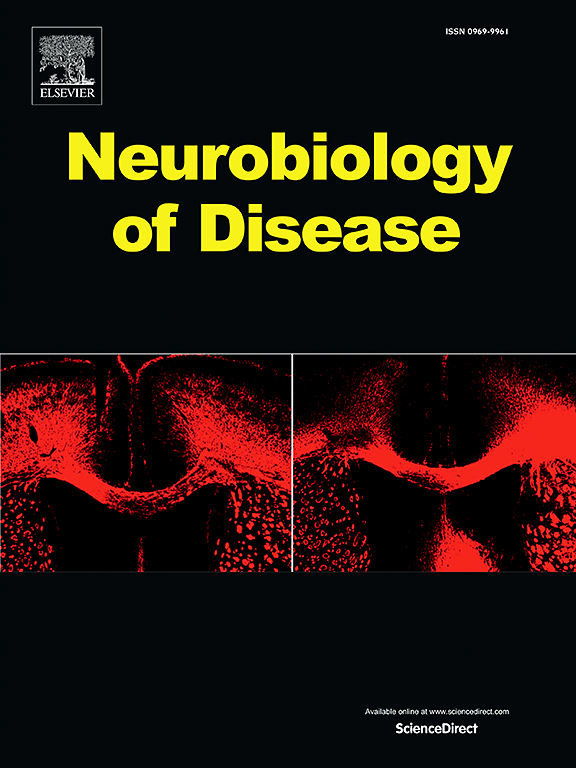Comprehensive characterization and validation of the Prp-hPFN1G118V mouse model: Guidelines for preclinical therapeutic testing for ALS
IF 5.6
2区 医学
Q1 NEUROSCIENCES
引用次数: 0
Abstract
The hPFN1G118V mouse model, overexpressing mutant human profilin1 linked to a rare form of ALS, was comprehensively characterized to assess its suitability for preclinical drug testing. Using a large cohort of nearly 250 transgenic and wild-type mice in a longitudinal study, we combined behavioral, electrophysiological, and neuropathological assessments to define the chronology of pathological events and assess inherent subject variability. The early stage of the disease in this model was characterized by elevated plasma neurofilament light chain levels, an effect that persisted and progressed throughout the course of the disease, followed by spinal cord neuroinflammation, suggesting that axonal pathology is the initiating event. The middle stage of the disease involved progressive neuromuscular decline, including reductions in compound muscle action potential (CMAP) and grip strength, accompanied by neuromuscular junction degeneration. The end-stage of the disease was characterized by the onset of visible changes such as weight loss, gait abnormalities and hindlimb paresis that quickly progressed to paralysis. At end-stage we also observed spinal motor neuron loss and TDP-43 pathology. The average humane endpoint was 213 days for females and 237 days for males. Our findings demonstrate that hPFN1G118V mice recapitulate key ALS features with moderate disease progression and a reproducible disease course, making them a valuable model for therapeutic testing. Recommendations are provided to optimize study design for preclinical testing, emphasizing survival duration as the primary endpoint, with CMAP and plasma NFL as key secondary readouts.
Prp-hPFN1G118V小鼠模型的综合表征和验证:ALS临床前治疗试验指南
hPFN1G118V小鼠模型过度表达与一种罕见ALS相关的突变型人类profin1,对其进行了全面表征,以评估其临床前药物测试的适用性。在一项纵向研究中,我们使用了近250只转基因和野生型小鼠的大型队列,结合行为、电生理和神经病理学评估来确定病理事件的时间顺序并评估固有的受试者变异性。在该模型中,疾病早期的特点是血浆神经丝轻链水平升高,这种影响在整个疾病过程中持续和发展,随后是脊髓神经炎症,这表明轴突病理是初始事件。疾病的中期涉及进行性神经肌肉衰退,包括复合肌肉动作电位(CMAP)和握力的减少,并伴有神经肌肉连接处变性。该疾病终末期的特点是出现明显的变化,如体重减轻、步态异常和后肢轻瘫,这些变化迅速发展为瘫痪。在终末期,我们还观察到脊髓运动神经元的丢失和TDP-43的病理变化。女性的平均人道终点为213天,男性为237天。我们的研究结果表明,hPFN1G118V小鼠概括了ALS的关键特征,具有中度疾病进展和可重复的病程,使其成为治疗试验的有价值模型。建议优化临床前试验的研究设计,强调生存时间是主要终点,CMAP和血浆NFL是关键的次要读数。
本文章由计算机程序翻译,如有差异,请以英文原文为准。
求助全文
约1分钟内获得全文
求助全文
来源期刊

Neurobiology of Disease
医学-神经科学
CiteScore
11.20
自引率
3.30%
发文量
270
审稿时长
76 days
期刊介绍:
Neurobiology of Disease is a major international journal at the interface between basic and clinical neuroscience. The journal provides a forum for the publication of top quality research papers on: molecular and cellular definitions of disease mechanisms, the neural systems and underpinning behavioral disorders, the genetics of inherited neurological and psychiatric diseases, nervous system aging, and findings relevant to the development of new therapies.
 求助内容:
求助内容: 应助结果提醒方式:
应助结果提醒方式:


